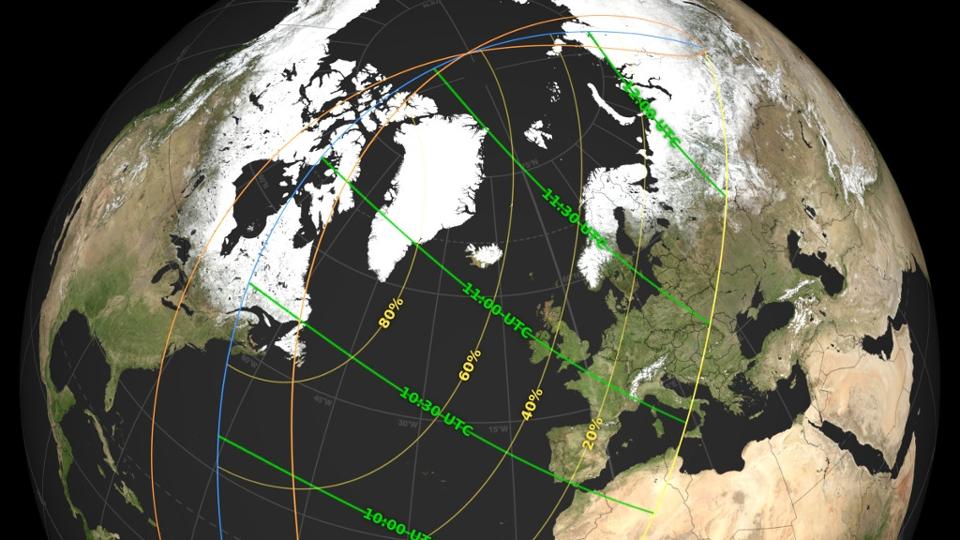


The first solar eclipse of 2025 will take place at sunrise on Saturday, March 29, with eastern Canada, the northeastern U.S., Europe and Africa all in the path. A deep partial eclipse will be seen from North America, with Canada seeing as much as 94% and the U.S. up to 85% of the sun blocked by the moon at the event’s peak. A smaller eclipse will be seen across western Europe and northwestern Africa later in the day. It comes in the wake of March 13-14’s “blood moon” total lunar eclipse seen from North America, and from the moon by a spacecraft.
A global map of the shadow path for the March 29, 2025 partial solar eclipse.
A partial solar eclipse — during which the moon’s dark central shadow, its umbra, just misses Earth and the moon appears to cover only part of the sun’s disk — will begin in Canada and the U.S. as a deep eclipse at sunrise and set in northern Russia as a slight eclipse.
Rare views of a deep eclipsed sunrise will be most easily visible along the Atlantic coast in northeastern U.S. states, particularly in Maine, New Hampshire and Massachusetts, and New Brunswick and Quebec, Canada.
From some locations in Maine, New Brunswick and Quebec, “devil’s horns” will be seen on the horizon as a horizontal “smiley face” shape appears, its cusps appearing separately to create a rare sight. Cities including New York (21%) and Boston (43%) will see the event, with more of the sun blocked by the moon from locations farther northeast.
The Nunavik region of Quebec, Canada, will see a maximum 94% eclipse at sunrise. According to Timeandddate.com, the point of greatest eclipse during a partial solar eclipse is always somewhere along the “terminator” line that divides the daytime and nighttime sides of the Earth.
In Europe, the eclipse will be seen in mid-morning, with London seeing 30%, Paris 23% and Berlin 15%. A slight eclipse will be visible in parts of northwest Africa and Russia.
Proper eye protection and solar filters on the objective lenses of a telescope or binoculars are essential to safely watch any part of this eclipse. Eclipse glasses that comply with the ISO 12312-2 international standard should always be used. Suppliers of safe solar eclipse glasses and solar filters can be found on the American Astronomical Society’s Suppliers of Safe Solar Filters & Viewers list. Pinhole projectors are a safe, indirect way to view the event.
This partial eclipse comes three years and nine months after a similar eclipse on June 10, 2021, when an annular solar eclipse in far north Ontario in Canada, Greenland and Russia caused a partially eclipsed sunrise to be seen from northeasten U.S. states. A 70%+ eclipsed sunrise was seen from Toronto, Philadelphia, New York and Boston.
The next solar eclipse visible in North America will be a small partial solar eclipse on Aug. 12, 2026, a total solar eclipse for eclipse-chasers in Greenland, Iceland and Spain. One complete Metonic cycle of the sun later, a total solar eclipse, will be seen across 13 U.S. states on Aug. 12, 2045. Before that, total solar eclipses will be seen from the U.S. Early on March 30, 2033, in Alaska and close to sunset on Aug. 22, 2044, in Montana and the Dakotas.

